How to customize your learning plan
In this article, we’ll look at how to customize a learning plan to reach your aspirations whether you are a beginner, hobbyist, or striving to grow as an artist full-time.
Disclosure: Some of the links on this page are affiliate links. I earn a reward or small commission when you use those links at no cost to you. Read more about the Affiliate Disclosure on the Terms page.
What is a “self-taught” artist?
Some say to be self-taught means to teach yourself without the aid of educational or instructional resources.
I think of self-taught as someone who has honed skills and grown knowledge by managing their own learning.
The term “self-taught” can be a topic of debate. It is interpreted in a wide range of nuances holding different meanings for some and others.
Most will agree that it means “figuring things out for ourselves” however how we go about figuring things is a grey area in terms of how it is defined.
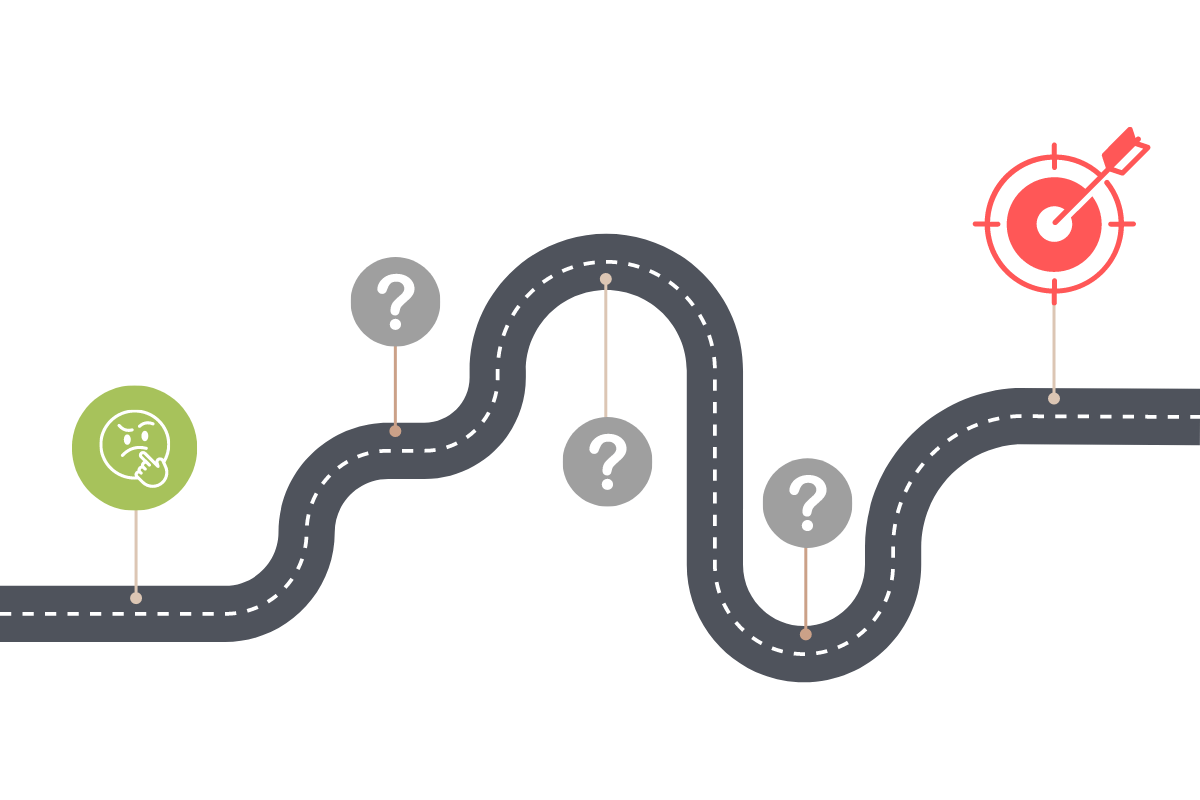
For this reason, I prefer to use the term “self-directed learning”.
From my viewpoint it holds the same meaning as self-taught, however for clarity let’s define it as an approach where we:
- make the effort to identify our own learning needs,
- set learning goals,
- find appropriate resources; and
- a reliable way to:
- assess our knowledge and skills, and;
- to gauge progress towards goals.

Limitations to self-directed learning
Without a prescriptive structure or external guidance to rely upon, managing our learning requires discipline coupled with a good dose of motivation to sustain our progress in a positive direction.
As well, it can be daunting to discern:
- what to learn
- how to learn it
- how to gauge our progress
So how do we get past these limitations?
It may seem like obvious common sense but before we can identify our learning needs, the first step is to define the desired outcomes.
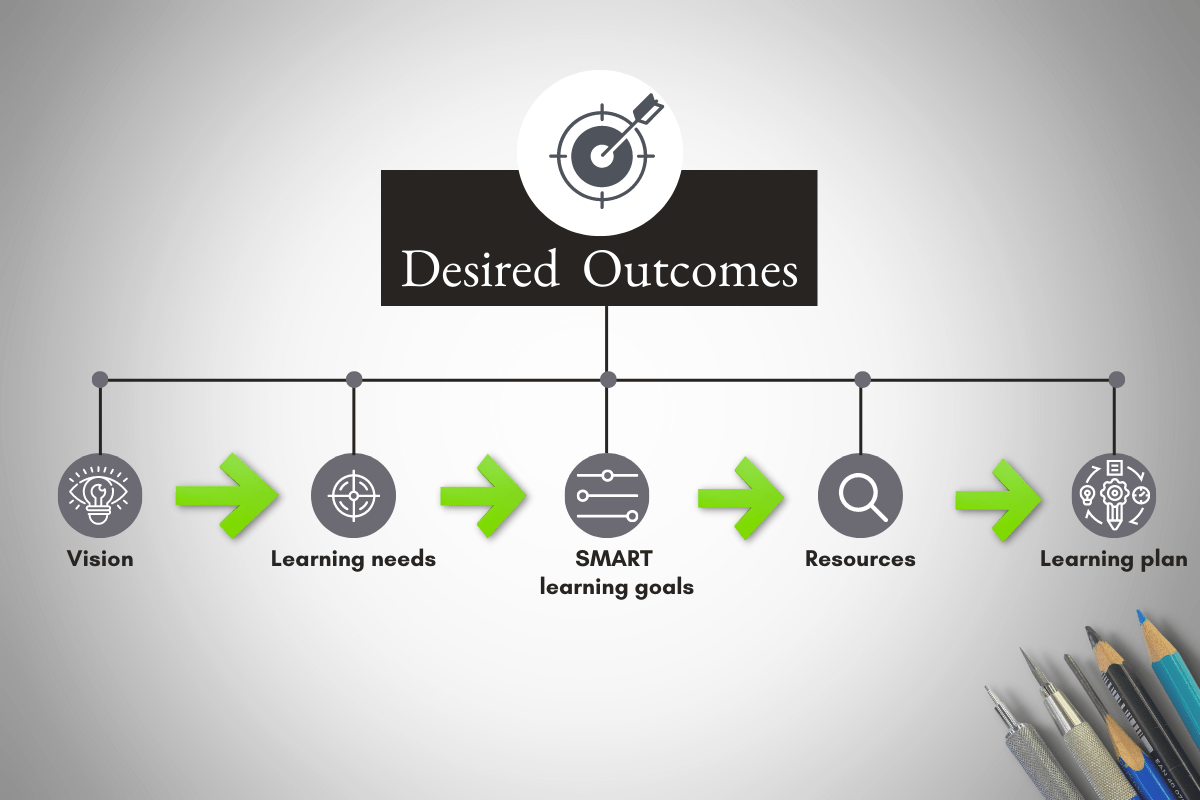
Step 01 – Determine your vision
Start with the end in mind because knowing where you want to go with your art will help determine the path to get there.
Hobby or profession?
- Are you exploring potential revenue streams for your art as a business?
- Are you pursuing personal development in art as a hobby?
- A bit of both?
For this example let’s say that we’re aiming for “a bit of both” because that’s where I was.
In the summer of 2020, I started doodling and people said “Hey, you’re pretty good”.
Encouraged, I signed up for random online drawing tutorials and practiced two-to-four hours a week.
A year later, while completely disengaged in a Zoom meeting for work, I noticed that my notebook was covered in (even better) doodles.
I got curious … How far could I take this?
I started daydreaming about having the freedom to spend more time doing art. To get there maybe I could:
- sell my drawings online or illustrate a book?
- table at Artist Alley on weekends at Comic-cons?
- accept commission work on the side?
These ideas lingered in my head for another year until I decided to write them down as concrete outcomes to strive for.
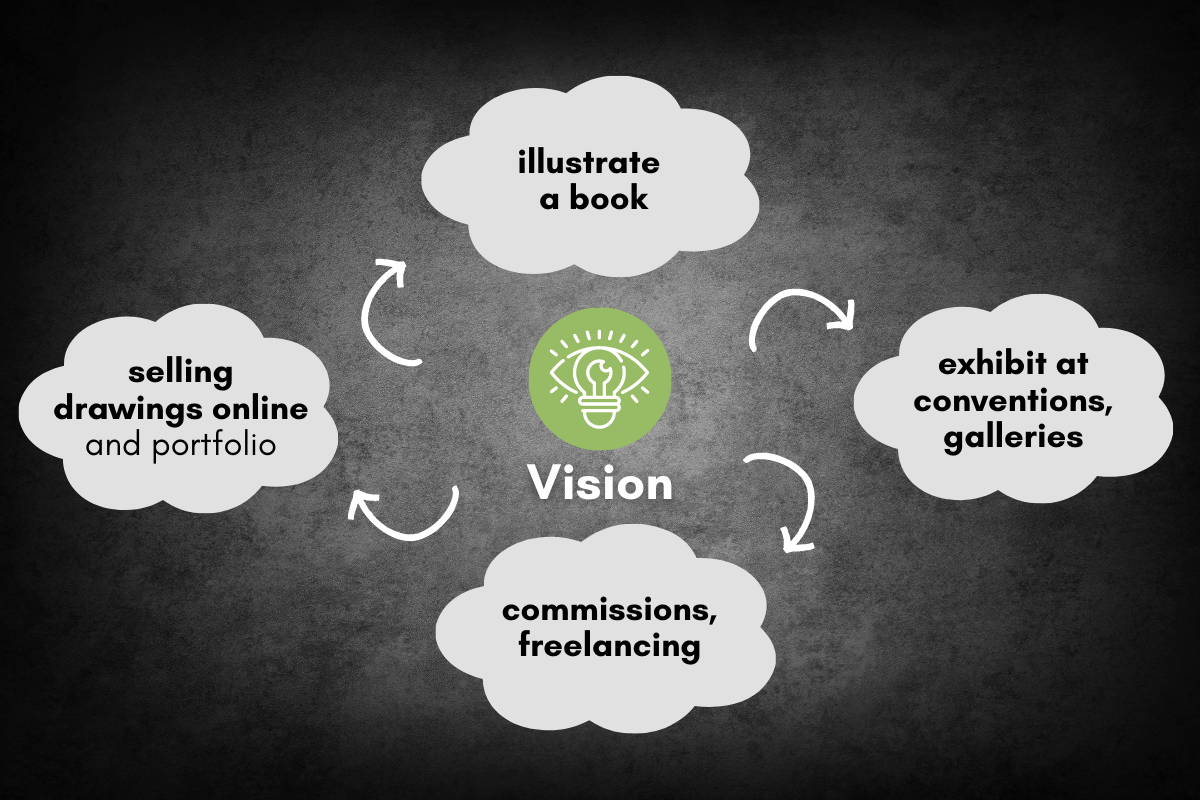
Take a few minutes to reflect on your top-of-mind desires.
- What have you been wanting to do?
- What would doing art accomplish for you and others?
- What would be the outcome – what is the “end goal”?
Visualize a clear picture in your mind of what you aspire to strive for.
Imagine, if there were no obstacles to realizing your outcomes … what kind of artist would you be?
Next, write down 3-4 concrete outcomes.
Using those ideas as the framework of where you want to go, you now have a vision for the future.
Step 02 – What are you doing now?
Where are you now? What is the current state?
What is the gap? What skills and knowledge are required to:
- act on that vision
- achieve your outcomes, the “end goal”
That’s when I assessed my work with a critical eye. I didn’t have a portfolio. I, therefore, flipped through my doodles, sketchbooks, and projects, and took note of:
- what I did well and
- what needed improvement
Self-assessment

Review your most recent artworks or the top three that you are most proud of.
Aim to select projects that each took about the same amount of time to execute – meaning compare sketches to sketches and finished art to finished art.
For example, below are two illustrations for comparison of progress over time (approximately 16 months apart). Each is a finished art piece of the same dimensions that took me an equal amount of time to execute.
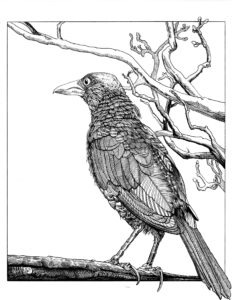
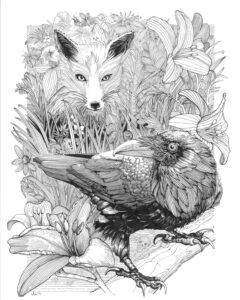
Looking at your best works:
- how does your current level of skill in your drawings compare to the level in your vision?
- how does your level of knowledge compare to the works of your Art Heroes?
- how well did you execute each of the art fundamentals?
- example: shape language, composition, visual story-telling, perspective, lighting and shading, mark-making techniques… etc.
Once you’ve answered the questions and noted specific things that you want to improve, these then become your learning needs.
If your aspirations are beyond a hobby, also review your methods and processes.
- Do you have a workflow? If yes, how effective is it?
- How consistently do you practice, and focus on learning? do you do warmups?
- What about your setup? Do you have a dedicated, organized space?
- Are the supplies you use of adequate quality?
- What changes would be helpful to your progress?
If looking to become a self-employed artist – what other gaps in skills or knowledge need to be addressed to earn a sustainable income with your art?
For example, I knew nothing about the behind-the-scenes tricks to promote my art on social media – things like SEO, Keywords, and Copywriting.
Learning needs will differ depending on your desired outcomes.
You may opt to focus primarily on growing your art skills. Or decide to align your efforts into turning that hobby into a career.
Your answers to these questions will then provide direction for setting specific learning goals.
Step 03 – Learning goals
It’s best to refine your learning goals using the SMART method.
Below is an example based on my desired outcomes.
Be specific with your goals
Specific: To grow my art skills & knowledge to the level where I can:
- sell my drawings (originals, prints, merch)
- illustrate a book
- exhibit at conventions, art fairs, galleries
- earn a consistent income with my art ($X amount/per year)
- measurable: in terms of the tasks to achieve those outcomes:
- complete one 200-page sketchbook within one year
- produce two finished projects of 20 hours each per month
- self-assess my work against the Fundamentals, bi-monthly
- optimize my workflow to gain 30 minutes back per day
- read 5 relevant books or/and complete an art-business course program this year
- find a mentor
Ensure you can achieve your goals
Achievable: ensure that you have influence over the outcomes.
For example, to reach a set number of original drawings sold or to be accepted into conventions are things I don’t have full control of – but I do have control over how many hours of practice I can invest.
Your goals must align with your vision
Relevant: double-check that your measures of success are directly related to bridging the gap from your current state to the desired outcomes.
Otherwise, they are either irrelevant or relevant but not a priority to succeed in your vision.
For example, completing a 200-page sketchbook is only relevant as a measure if it is filled with drawings that help you advance toward your vision.
I’m not saying that mindless doodling has no purpose, only that it has a lower priority compared to a task that brings you closer to realizing your desired outcomes.
Give yourself enough time
Time-bound: Set a schedule and milestone dates for completing each task.
This helps track progress and also serves as an opportunity to revisit goals should they no longer be relevant due to:
- changing circumstances
- a misjudgment of your learning pace
- personal capacity (watch for symptoms of burnout)
Using the smart method to set goals made managing my learning a lot easier.
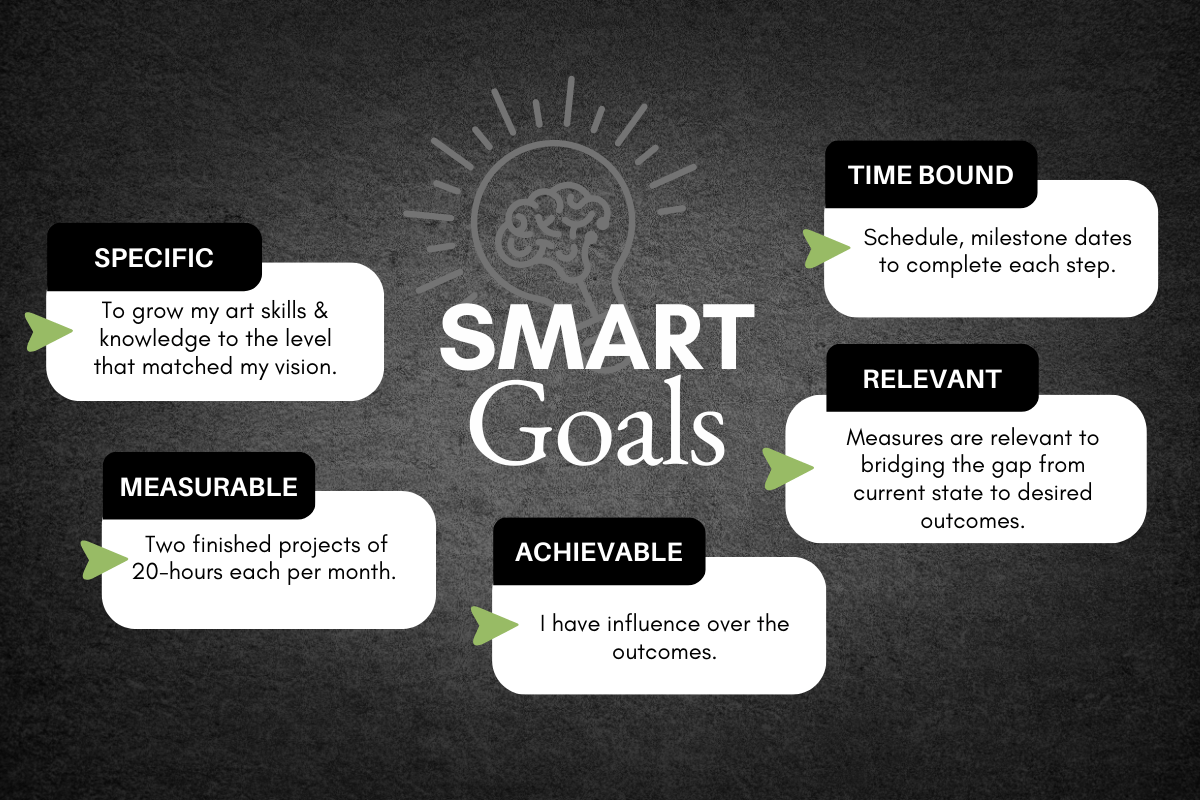
Review your vision periodically
Concrete, time-bound, well-defined tasks, also help with motivation to stay disciplined and perseverant.
It’s easy to have enthusiasm for doing the creative things we love and a lot less interesting when having to do tedious things.
I got discouraged when I realized that being a full-time artist meant spending energy learning topics outside of my area of interest.
For example, I have a WordPress website. I learned how to manage it, which takes a lot of discipline because this task is uninspiring to me. However, this is an activity that brings me closer to my end goal and therefore fuels my energy.
We don’t know what we don’t know.
As you make progress with your goals, you’ll gain more clarity about what is possible and what you truly want.
Be sure to review your vision periodically to adjust as you gain experience from working towards your goals.
Step 04 – Learning resources
When I assessed my art, what I identified as needing improvements were:
- anatomy/proportions
- lighting and shading techniques
- composition
- cleaner mark-making and linework
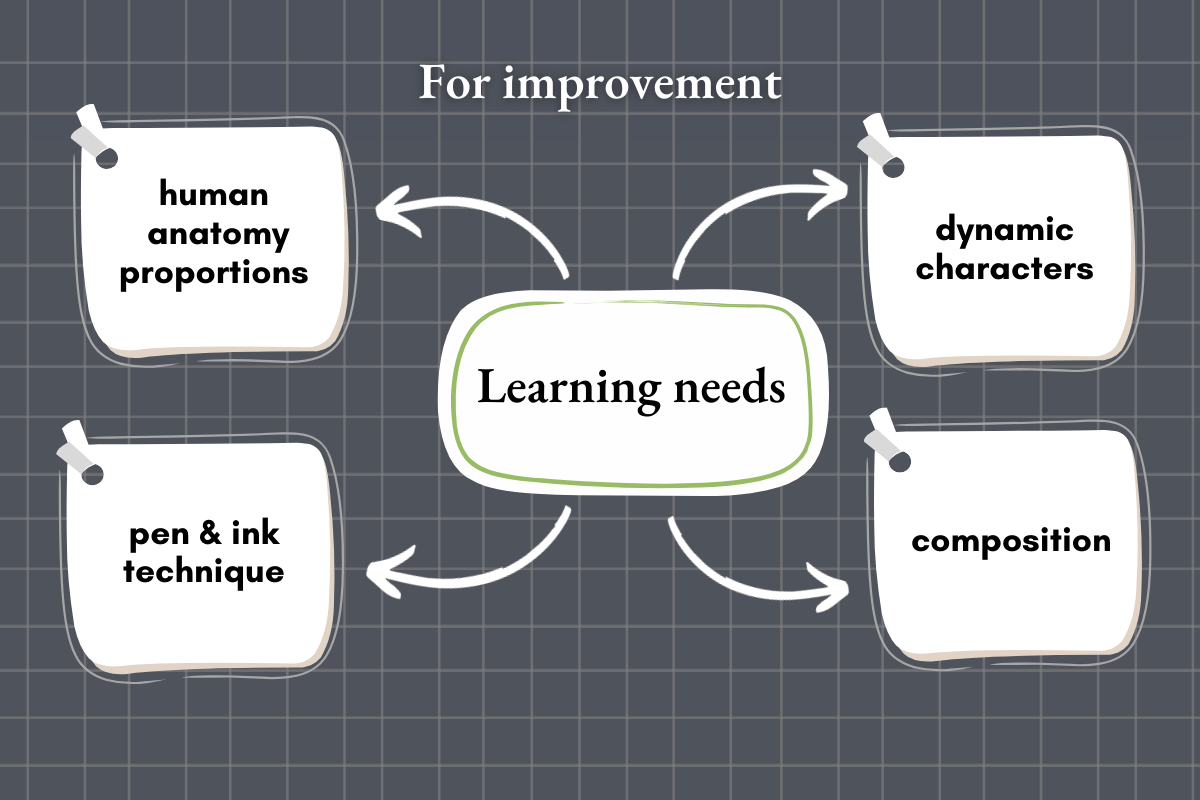
From there I looked for learning resources in those content areas.
Starting with a web search on “learning proportions in human anatomy” to see what came up, I then clicked on the top results to view their course curriculum.
Also, when searching for books online, if you’re able to peek inside at the table of contents – the listed topics are ideal for learning activities.
Otherwise, there is always the local library if peeking inside eBooks or samples are unavailable without a purchase.

Here is a sample Table of Contents from Arthur L. Guptill’s classic Rendering in Pen and Ink, which has long been regarded as one of the most comprehensive books published on the subject of ink drawing.
This is how I built my curriculum and at the same time gathered relevant resources.
However, be wary of rabbit holes. I got sidetracked by enticing tutorials and bargain sales but was saved by my SMART goals. Fun but unrelated topics got filed away for later into a low-priority folder.
I mentioned finding a mentor. In my long-time corporate career, I regularly had mentors and benefited greatly as a result. The organizations I worked for had formal mentorship programs which made the process more accessible. Now, as a self-employed artist matching my needs to the right (and affordable/available) mentor has been more challenging. Admittedly I’m still searching.
Sometimes, we just need a quick tip.
To validate my search efforts, I conducted information interviews. I contacted professional artists (whom I found on LinkedIn or follow on Instagram) asking for their advice on the resources I was considering, and if they could recommend anything else they found worthwhile.
Also, when I was accepted at a Comic-Con for the first time, I reached out to the same artists for their advice for my table setup.
📚 Read the Illustrator’s Guide to Artist Alley to prepare for your next Comic-con.
Now that we have all the pieces, let’s assemble a learning plan.
05 – Learning Plan
Below is my learning plan and click to download the PDF template version.
At the top is the vision of the future, where I want to go.
Underneath is the current state, where I’m starting from.
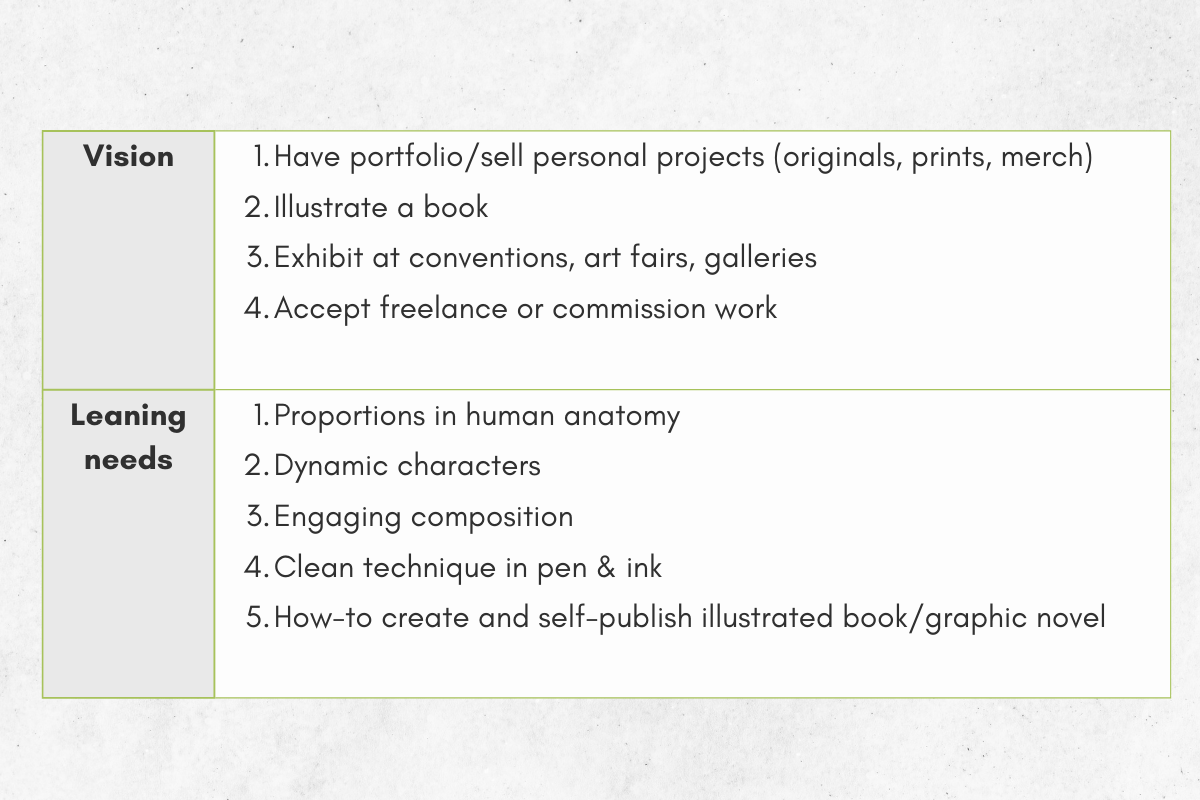
My learning needs become “lesson topics” for my custom learning curriculum.
From the results of my search on those lesson topics, I then created areas of study that became modules.
I created three modules however you can have as many as is manageable.
Also, write down the hours of study/practice that you’re aiming for.
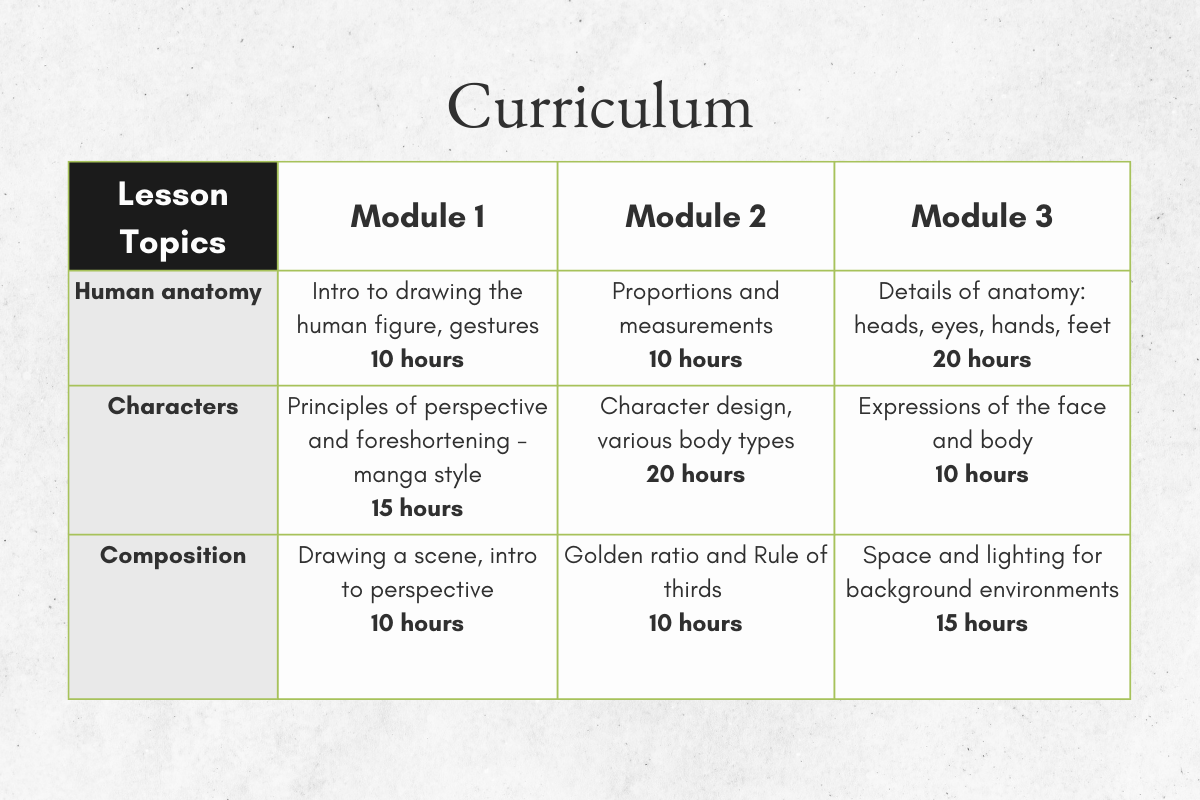
For each module, there are learning activities. Some of these are the tasks that you already established from our SMART goals exercise.
Anticipate that you will modify these tasks as you progress.
For example, if as part of your learning resources, you opted to take online courses or purchased a workbook with exercises, there likely will be assignments or projects.
These can be integrated into your curriculum as learning activities and outcomes.
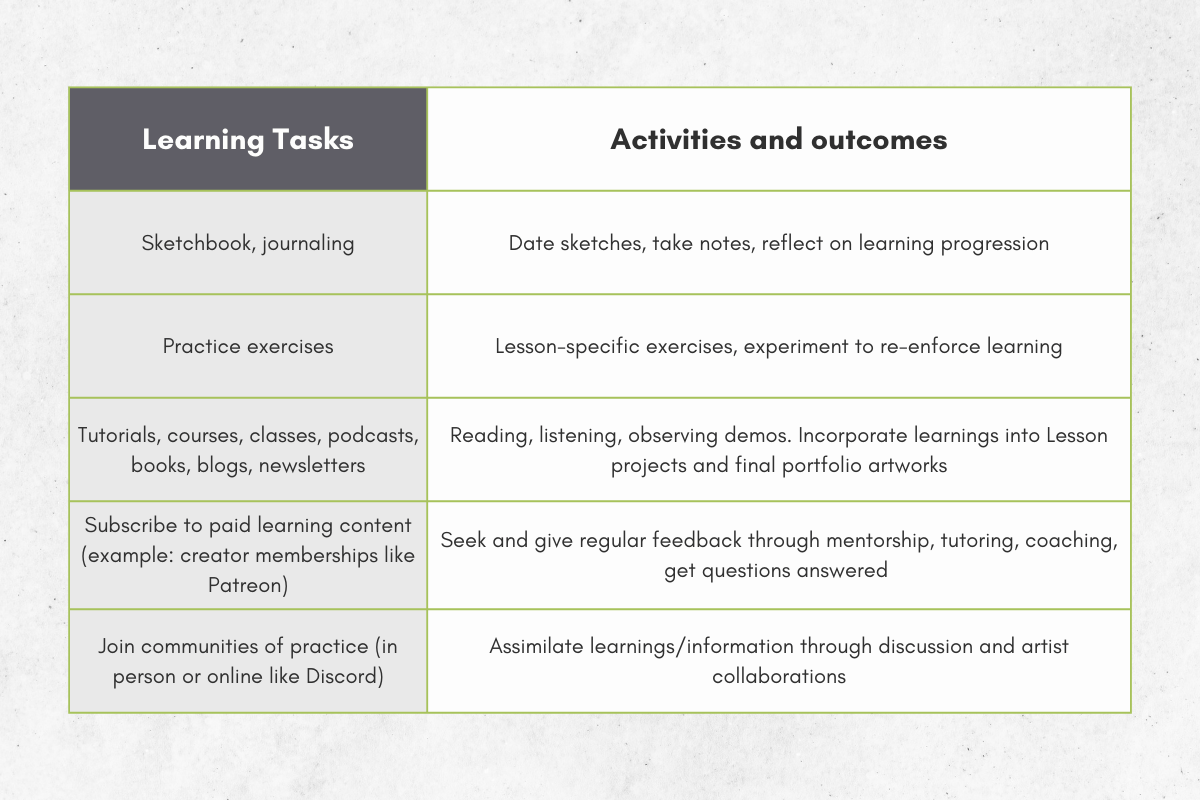
With this approach, the triage of information becomes pretty straightforward.
Once you’ve achieved all the tasks in your learning plan, you can go through the cycle again and increase or modify the challenge.

NOTE: The examples used in the learning plan template discussed in this article (HERE) differ slightly from the examples discussed for the template used in my YouTube video on the same topic. The principles and steps remain the same.
Best of luck customizing your learning plan using this five-step approach.
I hope that it will help you reach your aspirations – whether you are a beginner, hobbyist, or striving to grow as an artist full-time.
Resources
Visit the Tool page to find the materials you want for inking illustrations.
Browse the Longstride Illustration Pinterest Boards for more ideas.
Join me on Instagram to watch process videos and see finished art.
Interested in more templates?
Visit the DOWNLOADS category to browse learning resources.
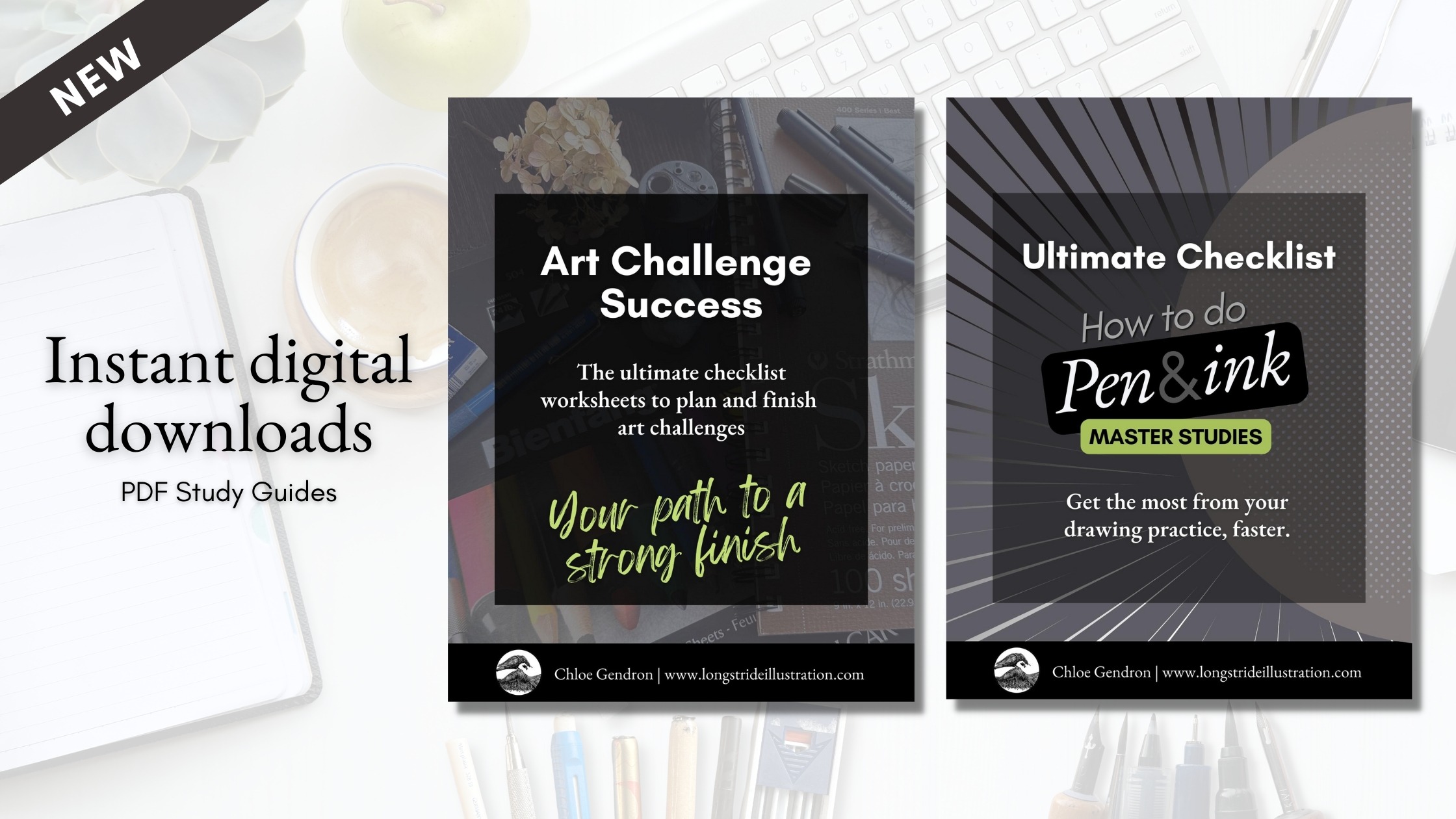

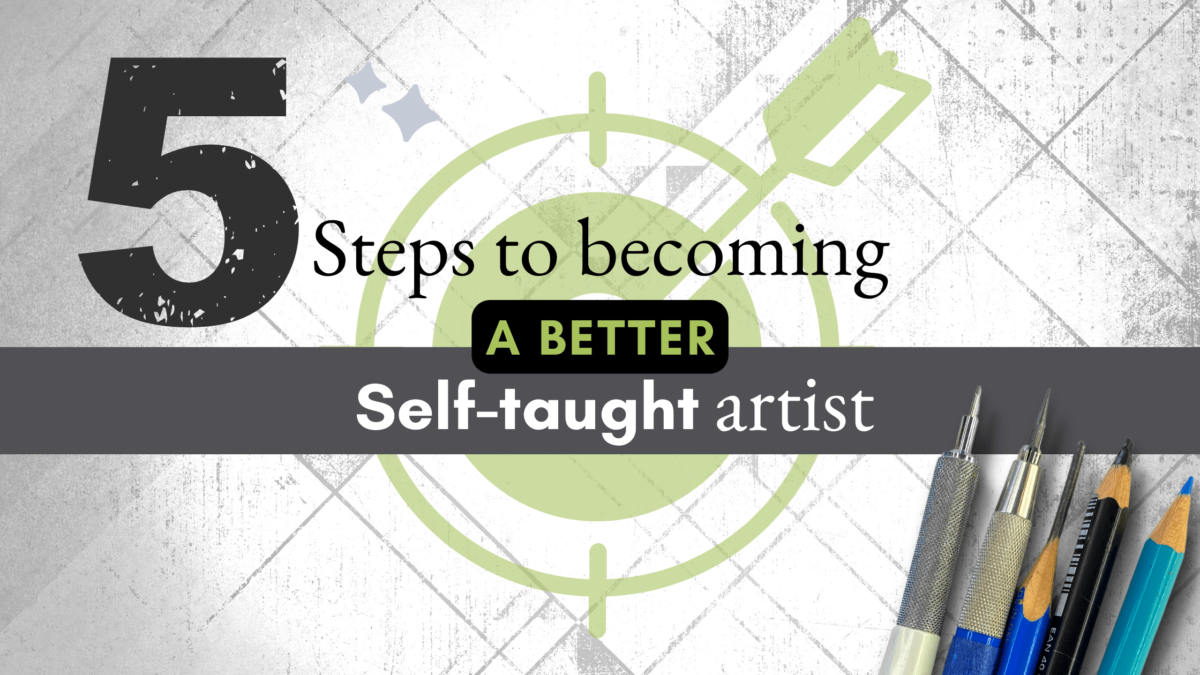



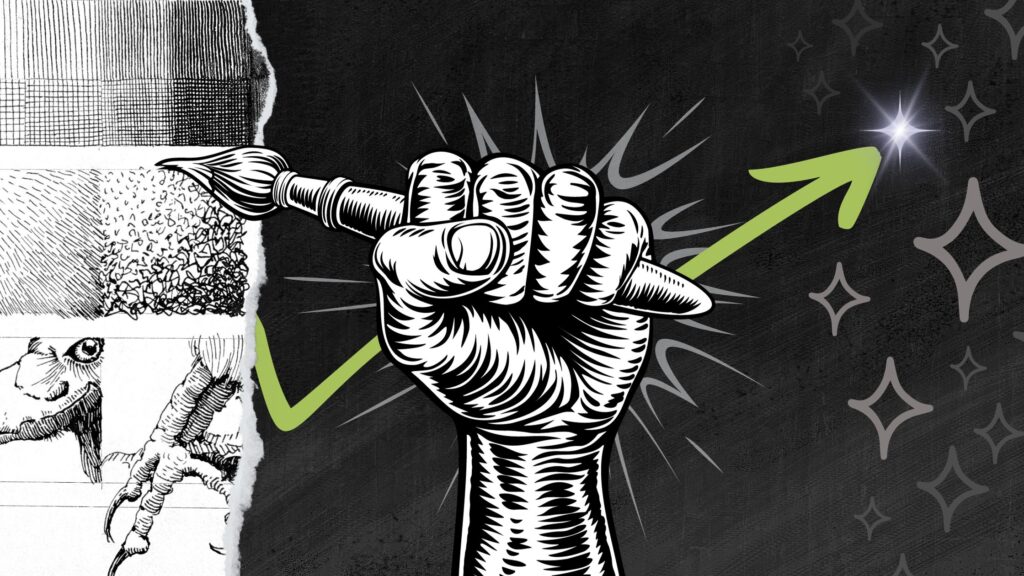
This is just terrific! I am thrilled for you, you must be very proud of what you’ve achieved! (What you’ve achieved SO FAR, that is!)
Here’s my favorite part…”In the summer of 2020, I started doodling and people said “Hey, you’re pretty good”.”
I agree.
Thank you George! That’s very kind to say 🙂
I am totally “gobsmacked” by your art and the wealth of tips you have been kind enough to leave for us. I’ve been visiting you for quite a while … Your NEW – Awesome Sauce Website totally rocks. I just wanted to THANK YOU!
I’m so happy that you like the new website and the blog. I’ll be publishing pen and ink content here regularly, so be sure to visit again. All the best with your art projects, Georgy!
I absolutely love your artwork. I start with pen and ink two months ago and was totally lost and did not really know how to start. I also want to do birds. Thank you for all your amazing YouTube videos and for taking the time to do that. I am learning a lot through them.
That makes me really happy to hear Aurelia! Glad that the videos and the posts are helpful in your new pen and ink adventures!
Your art is lovely! Thank you for creating and sharing this resource – it’s wonderful, esp. for those of us that are organizationally challenged!
Thank you so much Ayla! I’m glad you found my website and are enjoying the resources.